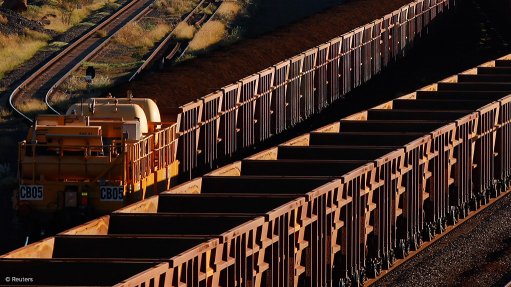Vale sees Moz mine as a ‘new reference’ for its coal business
Brazilian global major mining group Vale believes that its Moatize coal operation, in the Tete province of Mozambique, “will establish a new reference in the coal business”.
In a presentation in New York last month, Vale executive officer: fertilisers and coal Roger Downey affirmed that “Moatize is a world-class asset with potential to be one of the largest and most competitive metallurgical coal mines in the world”.
He pointed out that the Mozambique mine was an open-cut operation with 30 m seams, large-scale production, was expandable, would have a long life, was part of an integrated mine-railway-harbour operation and produced premium-quality hard coking coal. “Moatize will bring lowest-quartile-cost and premium hard coking coal to demanding markets,” he stated.
The Mozambique operation was expected to produce about 4-million tons this year – at full capacity, Moatize Phase 1 will be able to produce 11-million tons a year (Mt/y), composed of 8.5 Mt/y of metallurgical or coking coal and 2.5 Mt/y of thermal coal. From 2017 onwards, after the completion of Phase 2, it would have an annual production capacity of 25 Mt/y, which should continue all the way to 2042.
Currently, Moatize has a mine cost of $64/t free-on-rail. And, as for the railway, the Sena line last year demonstrated a much improved performance. Despite the February floods, which disrupted rail operations, the Sena line carried about 30% more coal in 2013 than in 2012. In October, it set a new monthly record of 340 000 t.
The Moatize Phase 2 mine and plant expansion will double the operation’s output by adding another 11 Mt/y in production capacity. Phase 2 will be commissioned during the second half of next year. Total capital expenditure for this expansion project will be $2.068-billion, of which $775-million had been spent by October last year, at which point the Phase 2 was 48% complete.
The second phase of Moatize is being paralleled by the development of the Nacala corridor to provide an alternative route for Moatize coal to the sea. This involves the laying of new track, mainly in Malawi, and the refurbishment of existing lines in Malawi and Mozambique, and the construction of a coal export terminal at the port of Nacala. The line from Moatize to Nacala will run for 912 km, while the Sena line from Moatize to the port city of Beira extends for 575 km.
The Nacala line and Nacala coal terminal will, naturally, have the same capacity – 18 Mt/y. The total capital expenditure for both the railway and port will be $4.444-billion, of which $1.059-billion had been expended by October. At that time, progress on the railway had reached 33% and 36% on the port. The railway is scheduled to start operating in the second half of this year and the port in the first half of next year.
Currently, Vale exports 42% of its total coal output (including from its Australian operations, which had a estimated run-of-mine production of 11.9 Mt last year) to Japan, with the other 58% going everywhere else. The group expects its total coal sales for last year to be 30% higher than in 2012. (Sales from its Australian operations alone rose some 34%.)
Regarding the global coal market, the mining group believes that the long-term fundamental factor will be urbanisation in Asian countries, particularly China and India. Seaborne coal supply is expected to grow at around 3% a year, but with downside potential. Vale sees the coal market as being oversupplied in the short to medium term and this will squeeze coal prices and margins worldwide. Prices could fall in the short to medium term and this could lead to the closing of more mines. This, in turn, will cause a supply shortage in the long term, which would result in higher prices. “Coal prices must improve to reduce pressure on margins and incentivise greenfield capacity to reverse the likely supply deficit,” argued Downey.
Comments
Press Office
Announcements
What's On
Subscribe to improve your user experience...
Option 1 (equivalent of R125 a month):
Receive a weekly copy of Creamer Media's Engineering News & Mining Weekly magazine
(print copy for those in South Africa and e-magazine for those outside of South Africa)
Receive daily email newsletters
Access to full search results
Access archive of magazine back copies
Access to Projects in Progress
Access to ONE Research Report of your choice in PDF format
Option 2 (equivalent of R375 a month):
All benefits from Option 1
PLUS
Access to Creamer Media's Research Channel Africa for ALL Research Reports, in PDF format, on various industrial and mining sectors
including Electricity; Water; Energy Transition; Hydrogen; Roads, Rail and Ports; Coal; Gold; Platinum; Battery Metals; etc.
Already a subscriber?
Forgotten your password?
Receive weekly copy of Creamer Media's Engineering News & Mining Weekly magazine (print copy for those in South Africa and e-magazine for those outside of South Africa)
➕
Recieve daily email newsletters
➕
Access to full search results
➕
Access archive of magazine back copies
➕
Access to Projects in Progress
➕
Access to ONE Research Report of your choice in PDF format
RESEARCH CHANNEL AFRICA
R4500 (equivalent of R375 a month)
SUBSCRIBEAll benefits from Option 1
➕
Access to Creamer Media's Research Channel Africa for ALL Research Reports on various industrial and mining sectors, in PDF format, including on:
Electricity
➕
Water
➕
Energy Transition
➕
Hydrogen
➕
Roads, Rail and Ports
➕
Coal
➕
Gold
➕
Platinum
➕
Battery Metals
➕
etc.
Receive all benefits from Option 1 or Option 2 delivered to numerous people at your company
➕
Multiple User names and Passwords for simultaneous log-ins
➕
Intranet integration access to all in your organisation


















